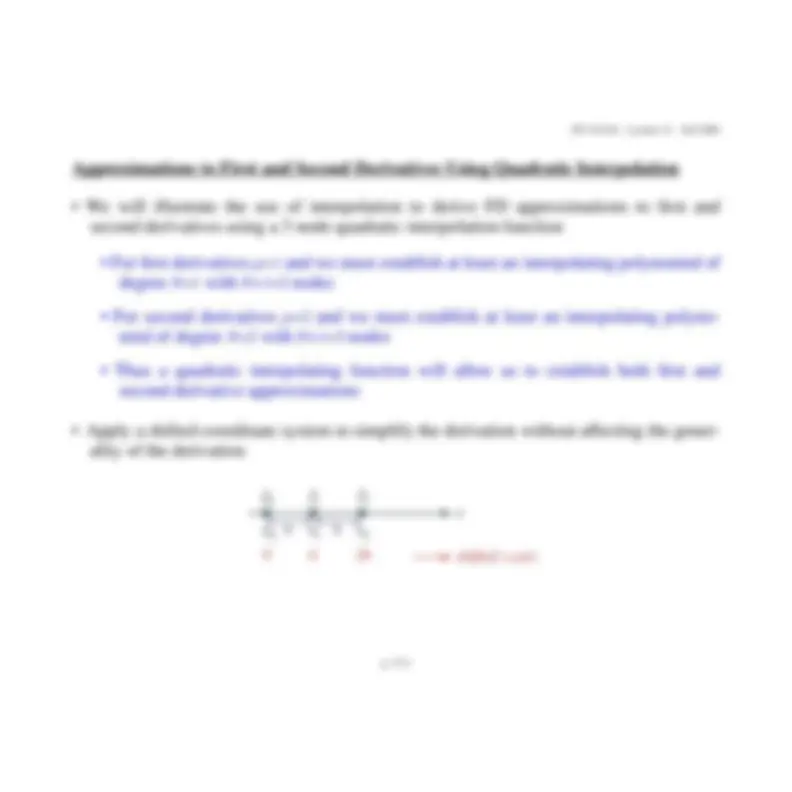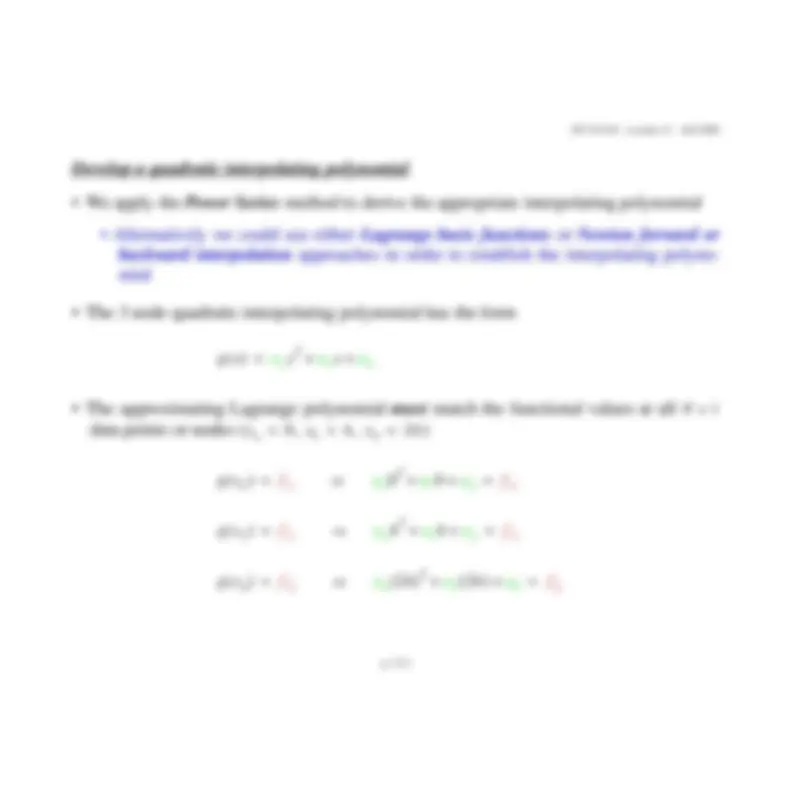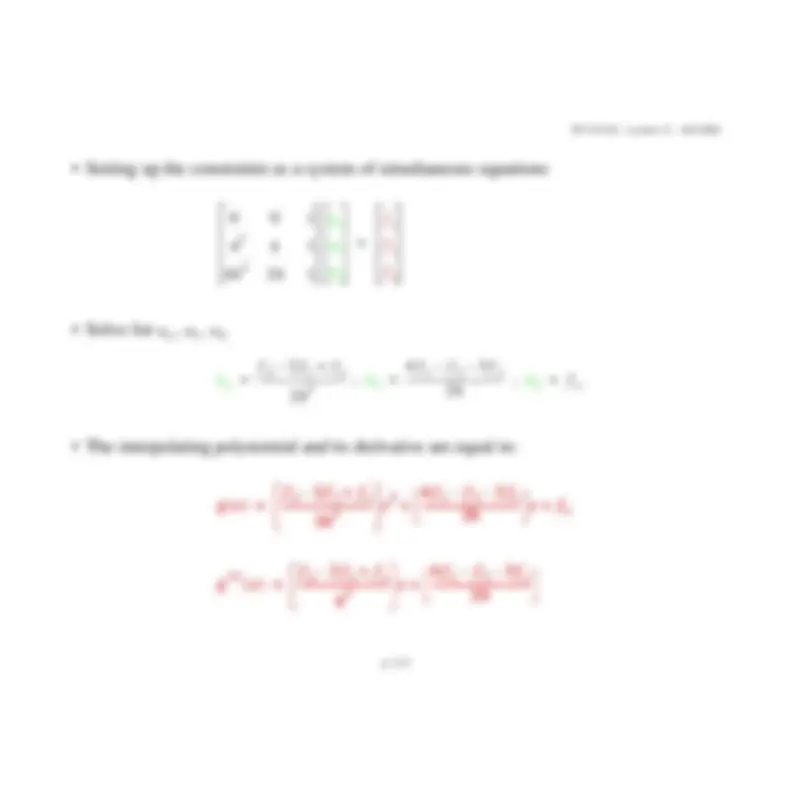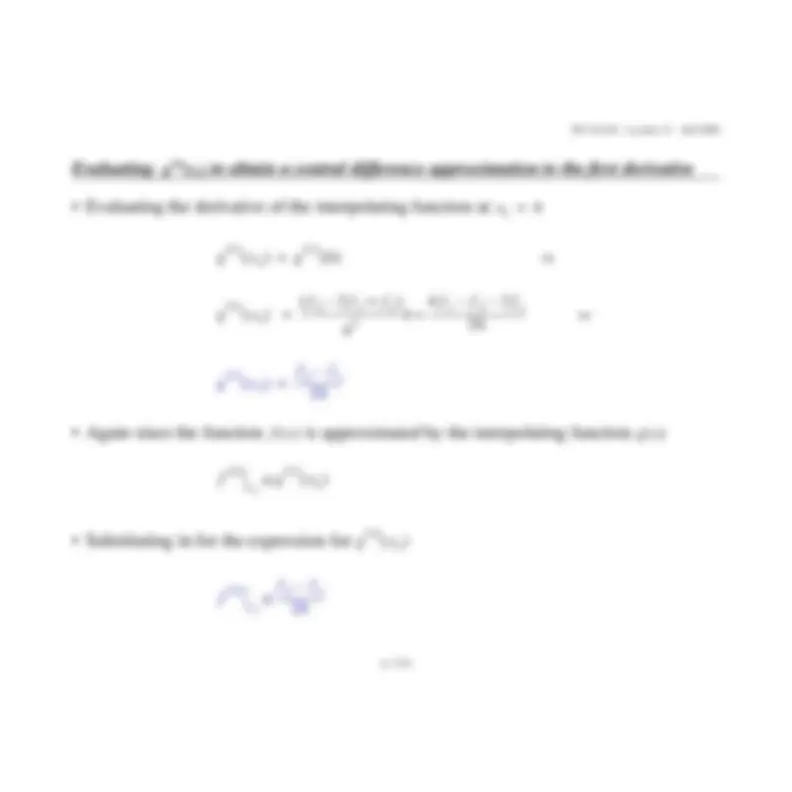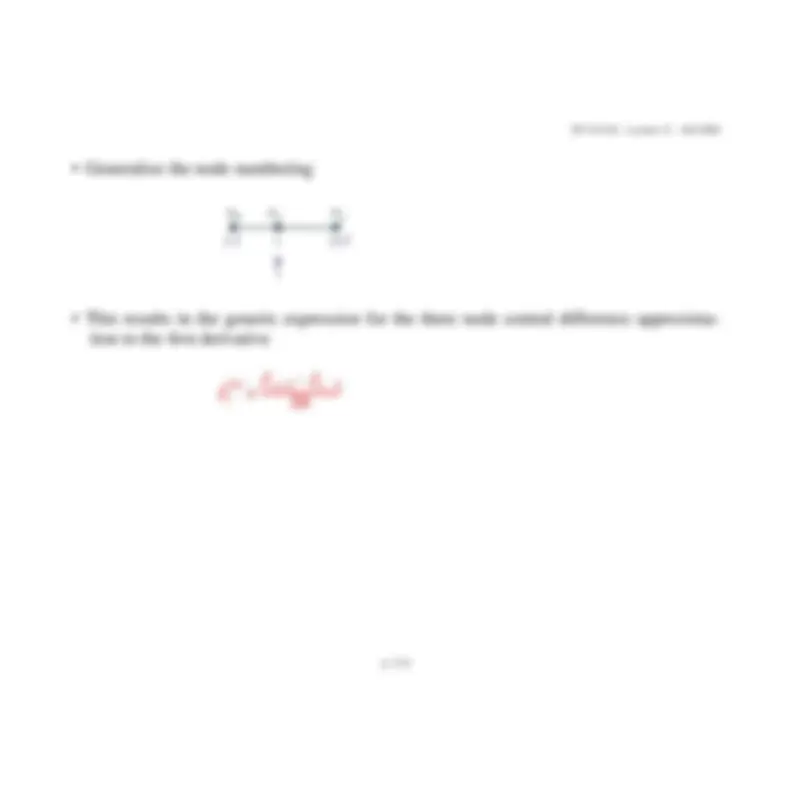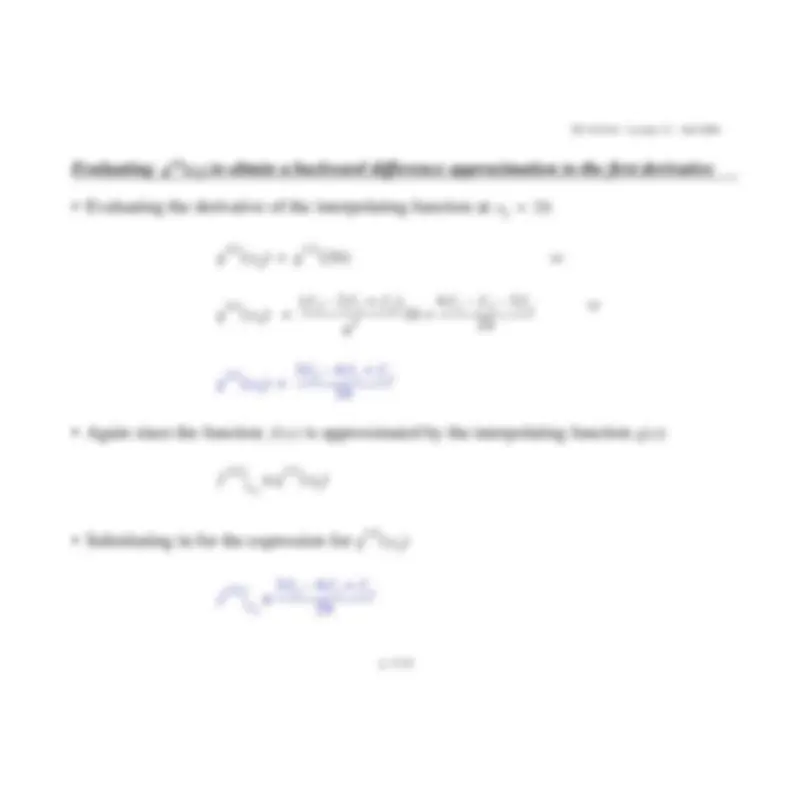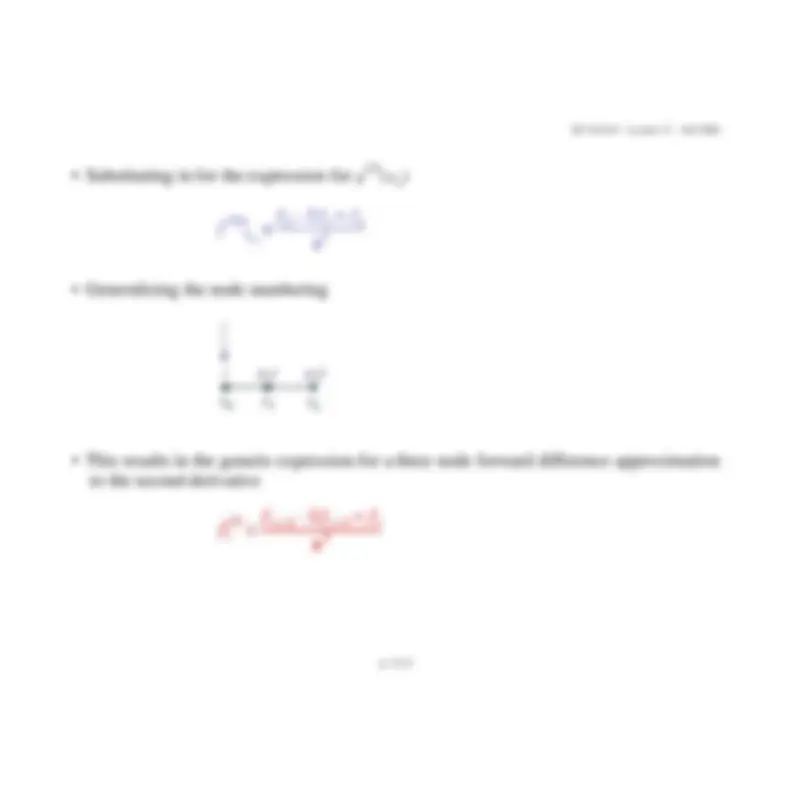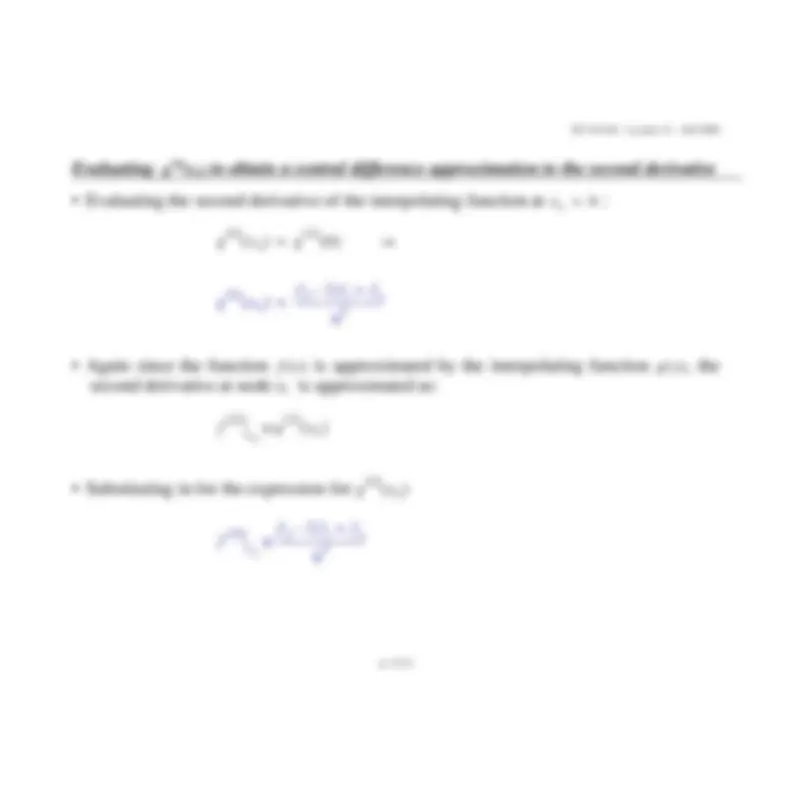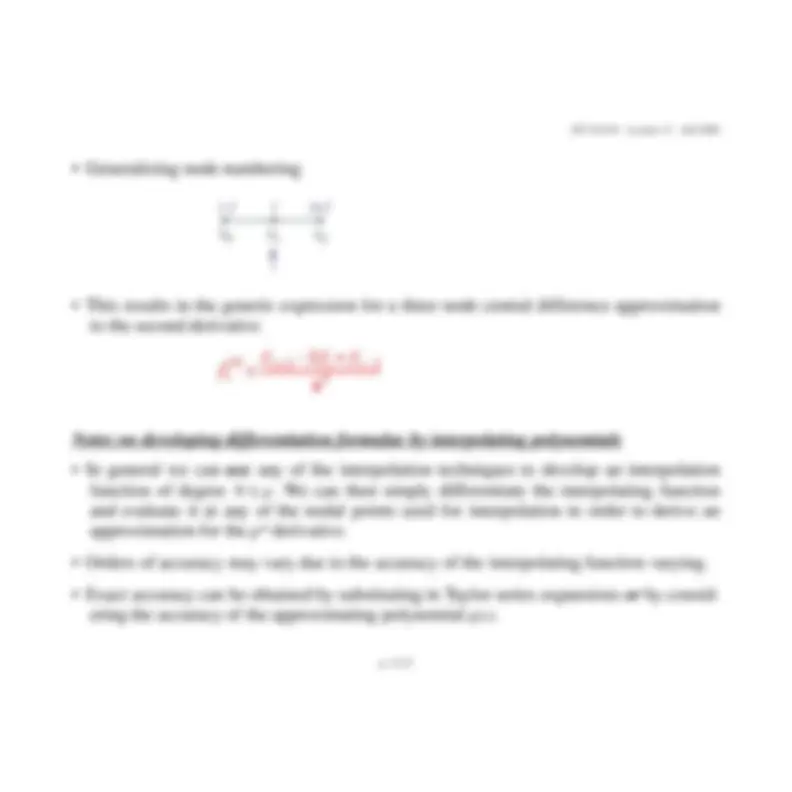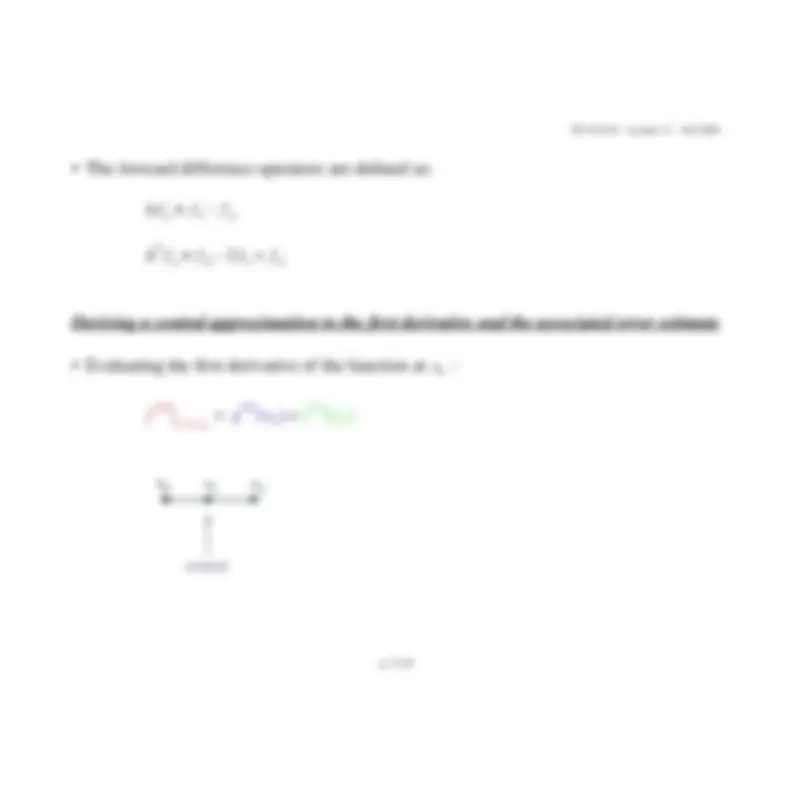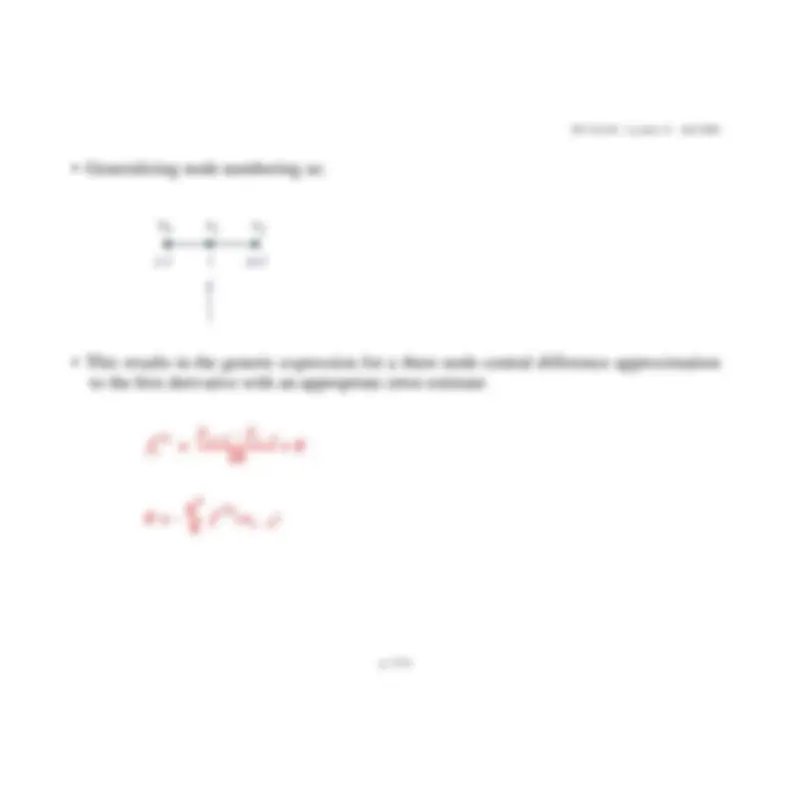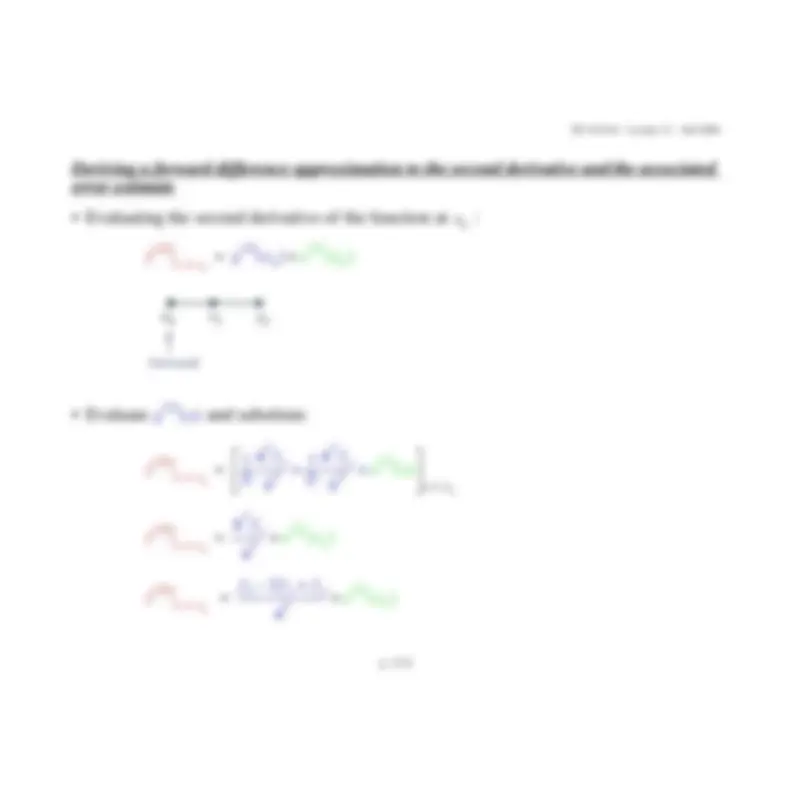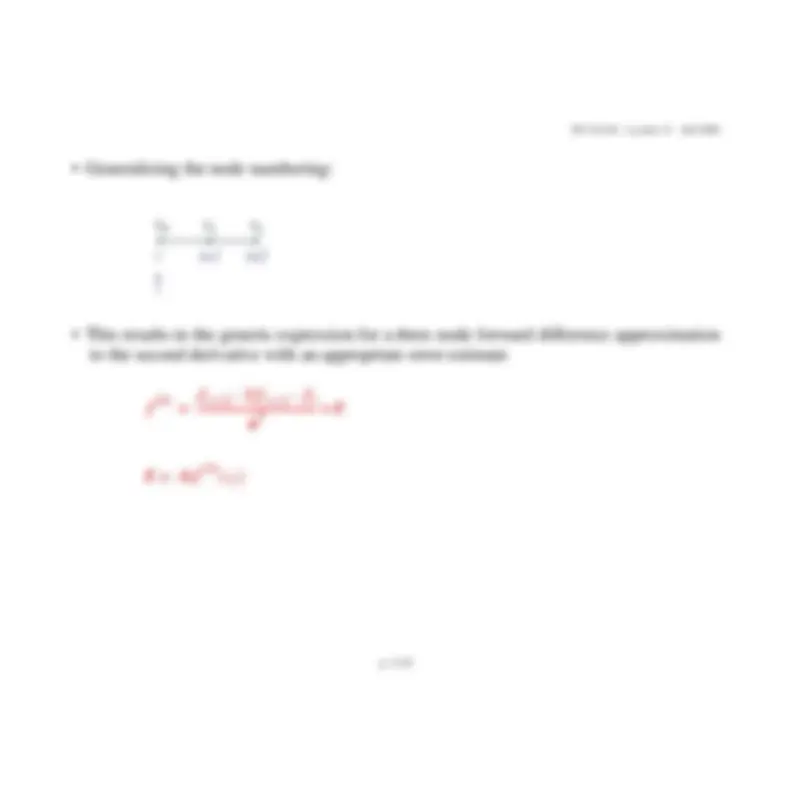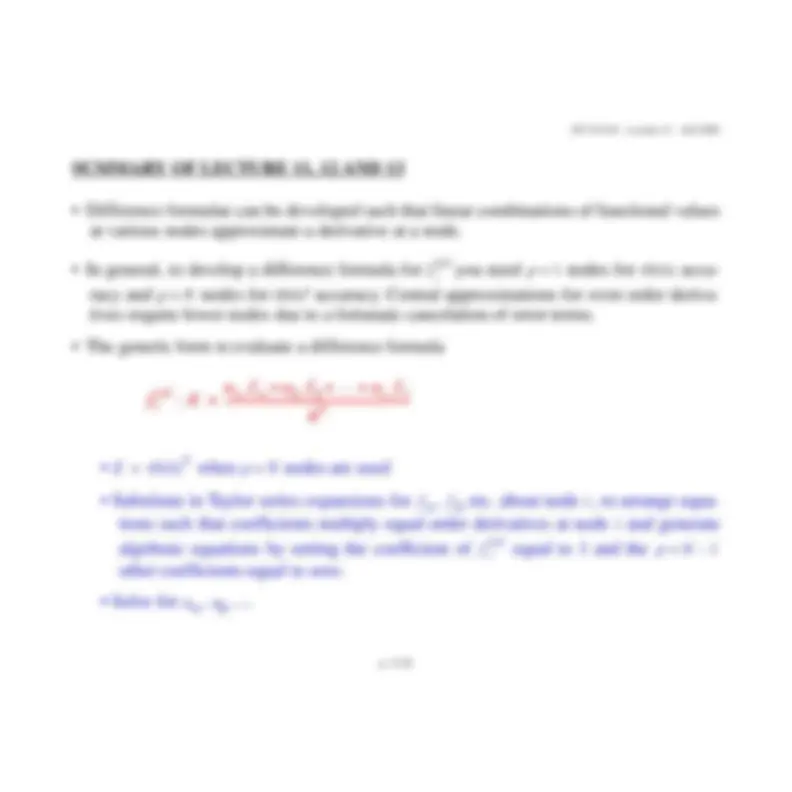Download Numerical Differentiation-Numerical Methods in Engineering-Lecture 13 Slides-Civil Engineering and Geological Sciences and more Slides Numerical Methods in Engineering in PDF only on Docsity!
CE 341/441 - Lecture 13 - Fall 2004
p. 13.
LECTURE 13NUMERICAL DIFFERENTIATION FORMULAE BY INTERPOLATING POLY-NOMIALSRelationship Between Polynomials and Finite Difference Derivative Approximations • We noted that
N
th^
degree accurate Finite Difference (FD) expressions for first derivatives
have an associated error
• If
f(x)
is an
N
th
degree polynomial then,
and the FD approximation to the first derivative is exact!
• Thus if we know that a FD approximation to a polynomial function is exact, we can
derive the form of that polynomial by integrating the previous equation.
E
h^ N^
d^ N^
1 +^
f
d x
N
1
d^ N
1 +^
f
d x
N
1 +
-----------------
-^
f^
x (
)^
a^1
x N
a
x 2 N
1
-^
a^ N
1 +
CE 341/441 - Lecture 13 - Fall 2004
p. 13.
• This implies that a distinct relationship exists between polynomials and FD expressions
for derivatives (different relationships for higher order derivatives).
• We can in fact develop FD approximations from interpolating polynomials Developing Finite Difference Formulae by Differentiating Interpolating Polynomials Concept • The approximation for the
derivative of some function
can be found by
taking the
derivative of a polynomial approximation,
, of the function
Procedure • Establish a polynomial approximation
of degree
such that
•^
is forced to be exactly equal to the functional value at
data points or nodes
• The
derivative of the polynomial
is an approximation to the
derivative of
p^ th
f^
x (
th p
g x
(^
f^
x (
g x
(^
)^
N
N
p ≥
g x
(^
)^
N
th p
g x
(^
)^
thp
f^
x ( )
CE 341/441 - Lecture 13 - Fall 2004
p. 13.
Develop a quadratic interpolating polynomial • We apply the
Power Series
method to derive the appropriate interpolating polynomial
• Alternatively we could use either
Lagrange basis functions
or
Newton forward or
backward interpolation
approaches in order to establish the interpolating polyno-
mial
• The 3 node quadratic interpolating polynomial has the form• The approximating Lagrange polynomial
must
match the functional values at all
data points or nodes (
,^
,^
⇒ ⇒ ⇒
g x
(^
)^
a^
xo 2
a
x 1
a 2
N
x^ o
x^1
h
x^2
h
g x
o (^
)^
f^ o
a^ o
2
a^1
a 2
f^ o
g x
1 (^
)^
f^^1
a^
ho 2
a^1
h^
a 2
f^^1
g x
2 (^
)^
f^^2
a^ o^
h (^
a 1
h (^
)^
a^2
f^^2
CE 341/441 - Lecture 13 - Fall 2004
p. 13.
• Setting up the constraints as a system of simultaneous equations• Solve for
,^
,^
• The interpolating polynomial and its derivative are equal to:
(^2) h
h^
h 2
h^
a^ o a 1 a 2
f^ o f^^1 f^^2
a^ o^
a^1
a (^2) a^ o
f^^2
f^^1
-^
f^ o
2
(^2) h
a 1
f^^1
f^^2
-^
f^ o
a 2
f^ o
g x
(^
)^
f^^2
f^^1
-^
f^ o +
2 h 2
-^
(^2) x
f^^1
f^^2
-^
f^ o
-^
x^
f^ o
g^
(^1) ( )
x (^
)^
f^^2
f^^1
-^
f^ o + h 2
-^
x^
f^^1
f^^2
-^
f^ o
h
CE 341/441 - Lecture 13 - Fall 2004
p. 13.
• Generalize the node numbering for the approximation• This results in the generic 3 node forward difference approximation to the first derivative
at node
i
i^
i+
i+
generalized nodal numbering
x^0
x^1
x^2
f^ i
(^1) ( )
f^ i
-^
f^ i
1 +^
f^ i
2 +
h
CE 341/441 - Lecture 13 - Fall 2004
p. 13.
Evaluating
( g 1) ( x
) 1
to obtain a central difference approximation to the first derivative
• Evaluating the derivative of the interpolating function at
⇒
⇒
• Again since the function
is approximated by the interpolating function
• Substituting in for the expression for
x^1
h
g^
(^1) ( )
x
1 (^
)^
g^
(^1) ( )
h (^
g^
(^1) ( )
x
1 (^
)^
f^^2
f^^1
-^
f^ o
(^
h 2
f^^1
f^^2
f^ o
h
g^
(^1) ( )
x
1 (^
)^
f^^2
f^ o
)^
g x
(^
f^
(^1) ( )
x^1
g^
(^1) ( )
x
1 (^
g^
(^1) ( )
x
1 (^
f^
(^1) ( )
x^1
f^^2
f^ o
CE 341/441 - Lecture 13 - Fall 2004
p. 13.
Evaluating
( g 1) ( x
) 2
to obtain a backward difference approximation to the first derivative
• Evaluating the derivative of the interpolating function at
⇒
⇒
• Again since the function
is approximated by the interpolating function
• Substituting in for the expression for
x^2
h
g^
(^1) ( )
x
2 (^
)^
g^
(^1) ( )
h (^
g^
(^1) ( )
x
2 (^
)^
f^^2
f^^1
-^
f^ o
(^
h 2
h^
f^^1
f^^2
f^ o
h
g^
(^1) ( )
x
2 (^
)^
f^^2
f^^1
-^
f^ o
2 h
= f x (^
)^
g x
(^
f^
(^1) ( )
x^2
g^
(^1) ( )
x
2 (^
g^
(^1) ( )
x
2 (^
f^
(^1) ( )
x^2
f^^2
f^^1
-^
f^ o
2 h
CE 341/441 - Lecture 13 - Fall 2004
p. 13.
• Generalizing the node numbering• This results in the generic expression for a three node backward difference approxima-
tion to the first derivative
x^0
x^1 i-
x^2 i
i-2^ f^ i
(^1) ( )
f^ i
f^ i
1
–^
f^ i
2
+
2
h
CE 341/441 - Lecture 13 - Fall 2004
p. 13.
• Substituting in for the expression for• Generalizing the node numbering• This results in the generic expression for a three node forward difference approximation
to the second derivative
g^
(^2) ( )
x
o (^
f^
(^2) ( )
x^ o
f^^2
f^^1
-^
f^ o
h 2
i+2^ x^2
i+1x^1
i x^0 f^ i (^2) ( )
f^ i
2 +^
f^ i
1 +
–^
f^ i +
h
2
CE 341/441 - Lecture 13 - Fall 2004
p. 13.
Evaluating
( g 2) ( x
) 1
to obtain a central difference approximation to the second derivative
• Evaluating the second derivative of the interpolating function at
⇒
• Again since the function
is approximated by the interpolating function
, the
second derivative at node
x
1
is approximated as:
• Substituting in for the expression for
x^1
h
g^
(^2) ( )
x
1 (^
)^
g^
(^2) ( )
h (^
g^
(^2) ( )
x
1 (^
)^
f^^2
f^^1
-^
f^ o
h 2
=^ f^
x (
)^
g x
(^
f^
(^2) ( )
x^1
g^
(^2) ( )
x
1 (^
g^
(^2) ( )
x
1 (^
f^
(^2) ( )
x^1
f^^2
f^^1
-^
f^ o
h 2
CE 341/441 - Lecture 13 - Fall 2004
p. 13.
Approximations and Associated Error Estimates to First and Second Derivatives Us-ing Quadratic Interpolation • We can derive an error estimate when using interpolating polynomials to establish
finite difference formulae by simply differentiating the error estimate associated withthe interpolating function.
• We will illustrate the use of a 3 node Newton forward interpolation formula to derive:
• A central approximation to the first derivative with its associated error estimate• A forward approximation to the second derivative with its associated error estimate
Developing a 3 node interpolating function using Newton forward interpolation • A quadratic interpolating polynomial (
) has 3 associated nodes (
) or
interpolating points. We again assume that the nodes are evenly distributed as:
• With a quadratic interpolating polynomial, we can derive differentiation formulae for
both the first and second derivatives but no higher
N
N
x^0
x^1
x^2
f^0
f^1
f^2
h^
h
x
CE 341/441 - Lecture 13 - Fall 2004
p. 13.
• The approximating or interpolating function is defined using Newton forward interpola-
tion as:
• The error can be approximately expressed in either of the following forms:• These latter two forms which do not involve
are more suitable for the necessary differ-
entiation w.r.t.
x
since
is functionally dependent on
x
, i.e.
f^
x ( )
g x
(^
)^
e x (
g x
(^
)^
f^ o
x^
x^ o
(^
f^
o h
x
x^ o
(^
)^
x^
x^1
(^
2 f^ o (^2) h
e x (
)^
x^
x^ o
(^
)^
x^
x^1
(^
)^
x^
x^2
(^
f
(^3) ( (^) )^
ξ(
x^ o
ξ^
x^2
e x (
)^
x^
x^ o
(^
)^
x^
x^1
(^
)^
x^
x^2
(^
f o
(^3) ( )
e x (
)^
x^
x^ o
(^
)^
x^
x^1
(^
)^
x^
x^2
(^
3 f^ o h 3
ξ
ξ^
ξ^
ξ^
x ( )
=
CE 341/441 - Lecture 13 - Fall 2004
p. 13.
• Evaluating
in the previous expression
g^
(^1) ( )
x (^
f^
(^1) ( )
x^
x^1
f^
o h
x
x^ o
(^
2 f^ o (^2) h
-^
x^
x^1
(^
2 f^ o (^2) h
-^
e^
(^1) ( )
x (^
x^
x^1
f^
(^1) ( )
x^
x^1
f^
o h
x
1
x^ o
(^
2 f^ o h 2
-^
e^
(^1) ( )
x
1 (^
f^
(^1) ( )
x^
x^1
f^^1
f^ o
1 ---^2
h -----^2 h
f^^2
f^^1
-^
f^ o
(^
)^
e^
(^1) ( )
x
1 (^
f^
(^1) ( )
x^
x^1
f^^2
f^ o
e^
(^1) ( )
x
1 (^
CE 341/441 - Lecture 13 - Fall 2004
p. 13.
• Now evaluate
using a non
dependent expression for the error term and evalu-
ating this expression at
• Substituting for
results in:
e^
(^1) ( )
x (^
)^
ξ
x^1
e^
(^1) ( )
x
1 (^
)^
f
(^3) ( (^) )^
x^ ( o
)^
x^
x^1
(^
)^
x^
x^2
(^
)^
x^
x^ o
(^
)^
x^
x^2
(^
)^
x^
x^ o
(^
)^
x^
x^1
(^
[^
] x
x^1
e^
(^1) ( )
x
1 (^
)^
f
(^3) ( (^) )^
x^ ( o
)^
x^1
x^ o
(^
)^
x^1
x^2
(^
e^
(^1) ( )
x
1 (^
)^
h
-^
f^
(^3) ( )
x
o (^
e^
(^1) ( )
x
1 (^
f^
(^1) ( )
x^
x^1
f^^2
f^ o
h
-^
f^
(^3) ( )
x
o (^

